MODERNITAS recommends: Exhibition "Colour Revolution: Victorian Art, Fashion, and Design"
A Vibrant Journey Through Victorian Splendour
The exhibition “Colour Revolution: Victorian Art, Fashion, and Design,” running until February 18, 2024, at the Ashmolean Museum Oxford, constitutes a fascinating journey into the colourful Victorian era. In a British society in which industrial advancements gradually take precedence over organic elements, the desire for colour converge with new scientific discoveries, giving rise to a revolution in the creation of new artifacts in a spectrum of new hues. The exhibition reveals the extent of the importance of colour and its key role in artistic and cultural creation in the XIXth and XXth centuries.
Responding to contemporary trends, Colour Revolution aligns with a recent revival of interest in the study of colours, as evidenced by the research one of MODERNITAS affiliated member, Paweł Mośicki (Polish Academy of Sciences). His lecture “What Color is the Color” given on September 7th 2023 at Maison des Sciences Humaines, disclosed his exploration of colours within historical and philosophical theories, in order to elucidate the symbolism and meaning behind the current use of colours. Acting as a practical visual, theoretical and material concretisation to this presentation, the exhibition provides a large display of 140 objects collected from international collections, facilitating comparisons across diverse forms of art and colour utilization.
“You ought to love colour, and to think nothing quite beautiful or perfect without it” John Ruskin, The Element of Drawing, 1857.
Departing from John Ruskin’s citation, the exhibition first unfolds around the analysis of pictorial compositions, displaying paintings by the Victorian polymath and his circle: Rosetti, Turner, etc. This introduction successfully underscores the significance of colours for the artist, but also for the observer, whose eyes unconsciously encounter a multitude of nuances at every instant.
This desire to draw our attention to the everyday use of colours propels the exhibition to guide us into the colourful world of applied arts, such as in textiles and fashion, or in design and furniture. Following this interdisciplinary line, the Ashmolean exhibits a variety of chic corsets and sophisticated dresses in captivating shades, but also objects, work tools, appliances, sculptures, paintings, etc. Such a wide-ranging collection of artistic manifestations allows the juxtaposition of illustrious creations like the Ashmolean’s remarkable Great Bookcase (1859-62), or influential pre-Raphaelites paintings, alongside trivial undergarments or eccentric objects. Among those, the audience will notice Harry Emmanuel’s Hummingbird necklace (1865): a necklace designed from painted bird heads. The strategic contiguity of those peculiar objects highlights the importance of visual aesthetics and craft production in an increasingly industrial and seemingly monochromatic society.
This multitude of rarely displayed objects also touches on the social implications of colours in modern society. Expanding the definition of art, the exhibition also addresses the provocative symbolic behind the colour yellow with a display of the influential decadent periodical “The Yellow Book” (1894), or the socio-economic difference inherent in the colour blue, which only the riche bourgeoisie could afford to wear, as shown in the famous painting “April Love” (1855–56) by Arthur Hughes. Similarly, John Bell’s sculpture “Daughter of Eve” (1853) raises the serious question of transatlantic slavery and the use of colour as a tool of social segregation. The inclusion of such a topic adds a crucial layer of historical context in different national spaces. Indeed, the exhibition embraces a highly transnational dynamic and extends beyond Europe, bringing art from America and Japan as well.
With an intricate layout featuring explanatory texts and exhibited books, paintings, clothing, statues, or even brief video abstracts, this labyrinthine exhibition reinforces the feeling of omnipresence of colours, despite the general tendency to overlook their significance. Audiences will emerge from this immersive experience with eyes enchanted by the magic of colours and minds enriched with new insights into its use and evolution. Given its extensive coverage of diverse subjects and art forms, this exhibition appeals to a broad audience, including both aware scientists and those new to the subject.
Written by Eve Filée
Event Details: Date: 21.9. 2023 - 18.02.2024 Location: Ashmolean Museum, Oxford
Image : "Study of a Kingfisher", John Ruskin, watercolour, 1871 © Ashmolean Museum

